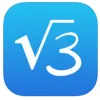Take a look inside 5 images
MyScript Calculator
Pros: Makes using a calculator more fun and engaging; helps integrate technology into the math classroom.
Cons: Kids may need a lot of practice to master some symbols. Equations have to be drawn carefully so the app can recognize and process them correctly.
Bottom Line: This innovative and useful tool adds interest and engagement to an otherwise dull task. And it's free!
Given its universal ability to calculate a range of equations, from simple to fairly complex, MyScript Calculator could be used in most mathematics classrooms. Of course, the goal is not to teach kids how to solve equations, but rather to integrate technology into the classroom. It could be fun to have kids use the app to check their work. For example, when kids finish a worksheet you've assigned, have them work individually or in pairs to check their answers by handwriting the equations and cross-checking the calculated answers with their own.
MyScript Calculator is a calculator app that allows users to hand-write math operations that the app then solves. When kids first open MyScript Calculator, a five-step tutorial walks them through important functions of the app. When they're finished watching the tutorial, a grid-like screen appears, and they can simply begin using their fingers to draw equations directly on the screen. The app processes whatever is drawn into digital format, and the results are immediately calculated. Kids can edit equations by scratching over numbers and symbols to delete them. When they're finished, they can email or copy their work, or use Airdrop to share it. Customizable settings include setting the number of decimal places, using left-handed writing, and turning automatic calculation on or off. A single $.99 in-app purchase unlocks the ability to continue a long operation or use the result in a new calculation, save results into memory and use them anytime, and access all past calculations for reuse or export.
Kids can learn how to use technology to solve equations: They hand-write equations, the app processes those equations and transforms them into digital format, and then, as with a traditional calculator, the device calculates the answer. Kids can use scratch-out gestures to delete parts of the equations as needed. Unfortunately, the app doesn't have a memory feature, so multi-step equations may have to be written on paper. Nonetheless, having kids use a digital calculator is a great way to integrate technology into the classroom and engage kids a bit more in crunching numbers. Kids won't learn how to solve equations, but they will learn how to use up-to-date touchscreen technology.












